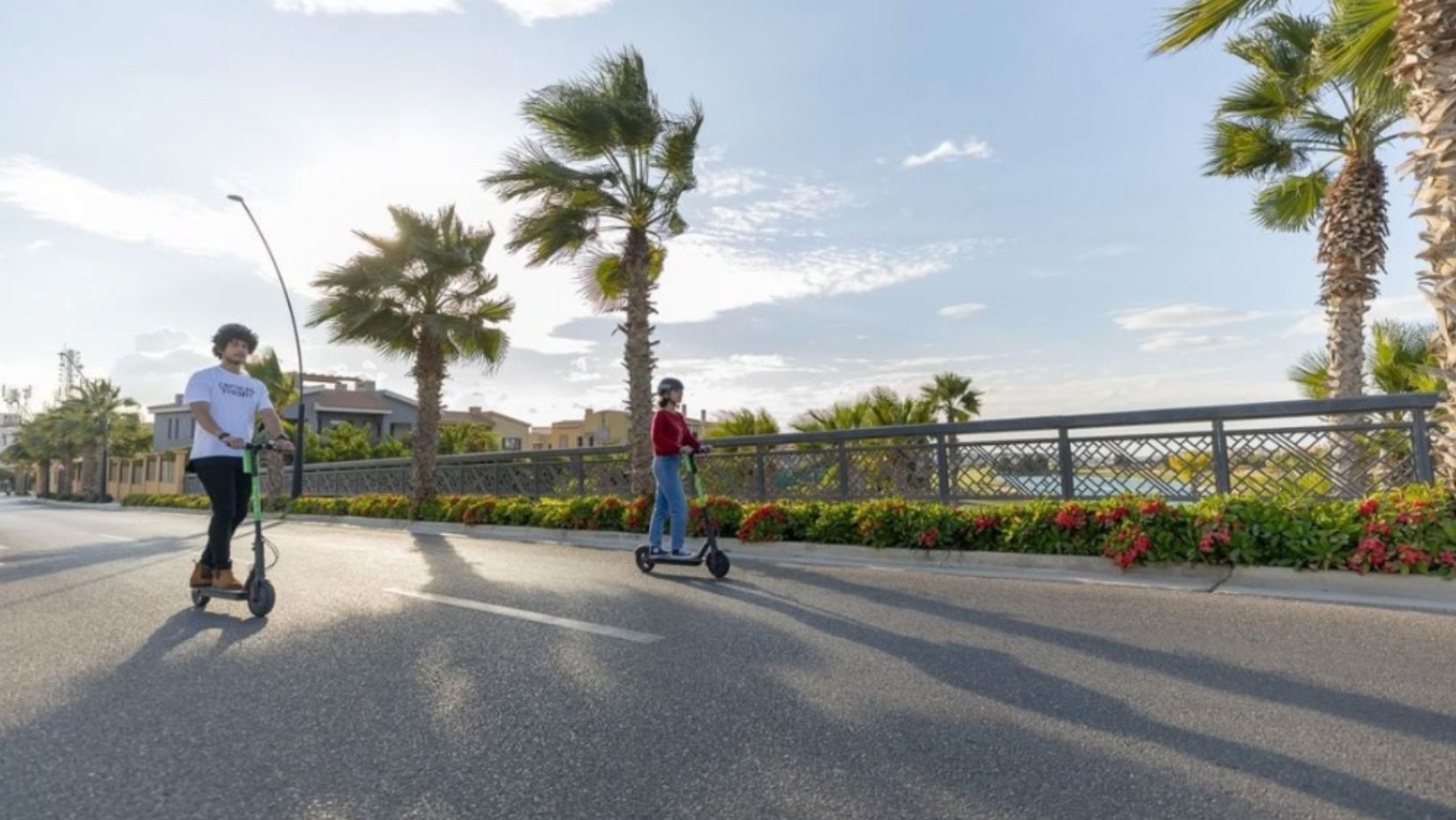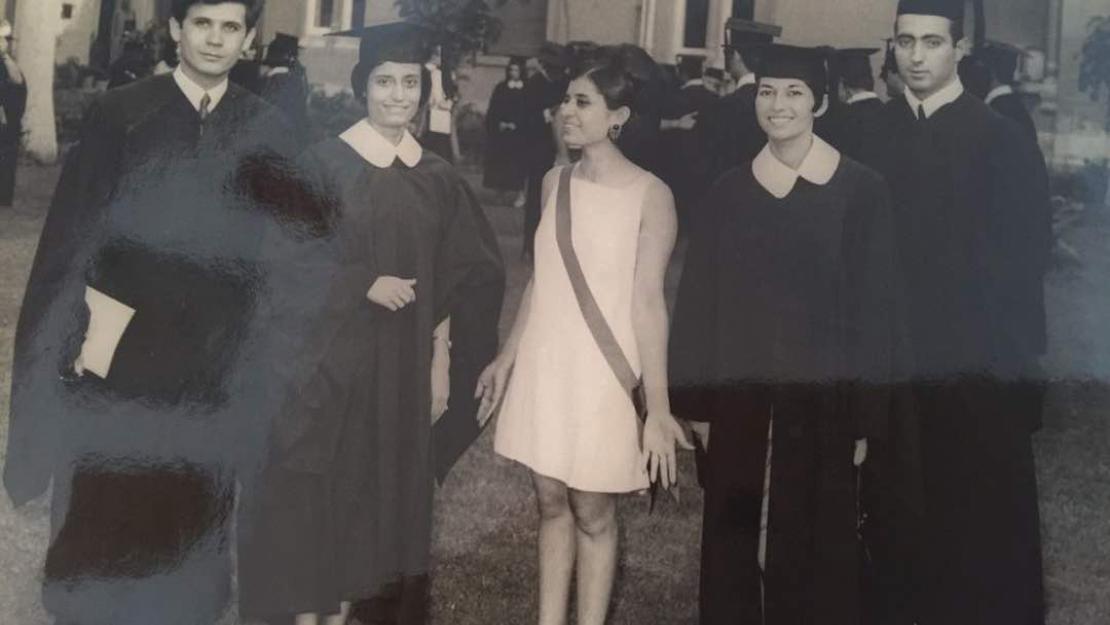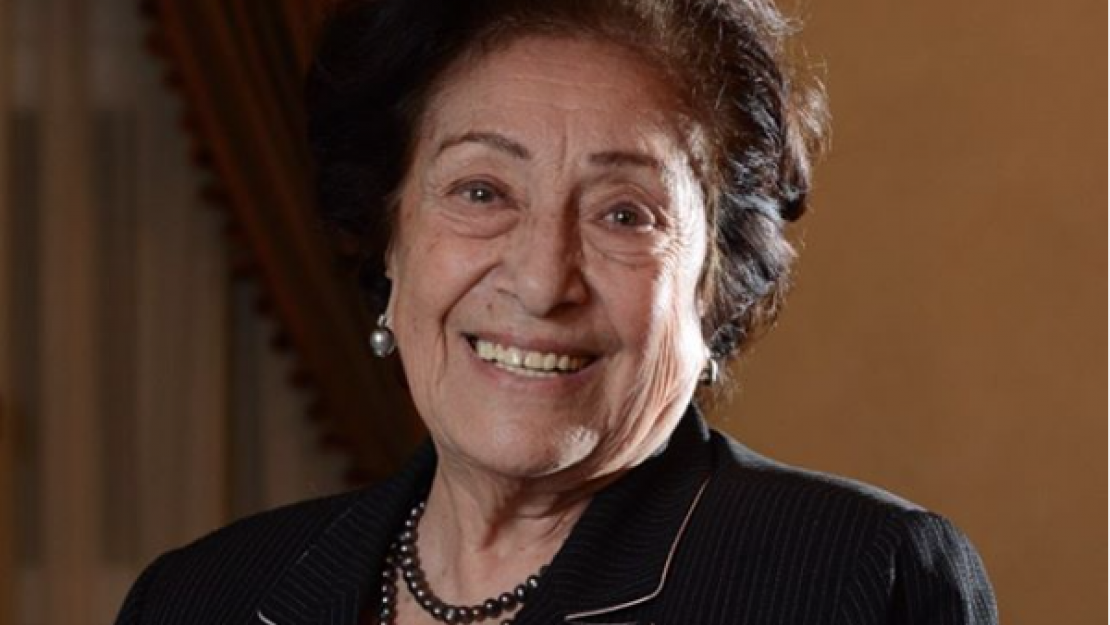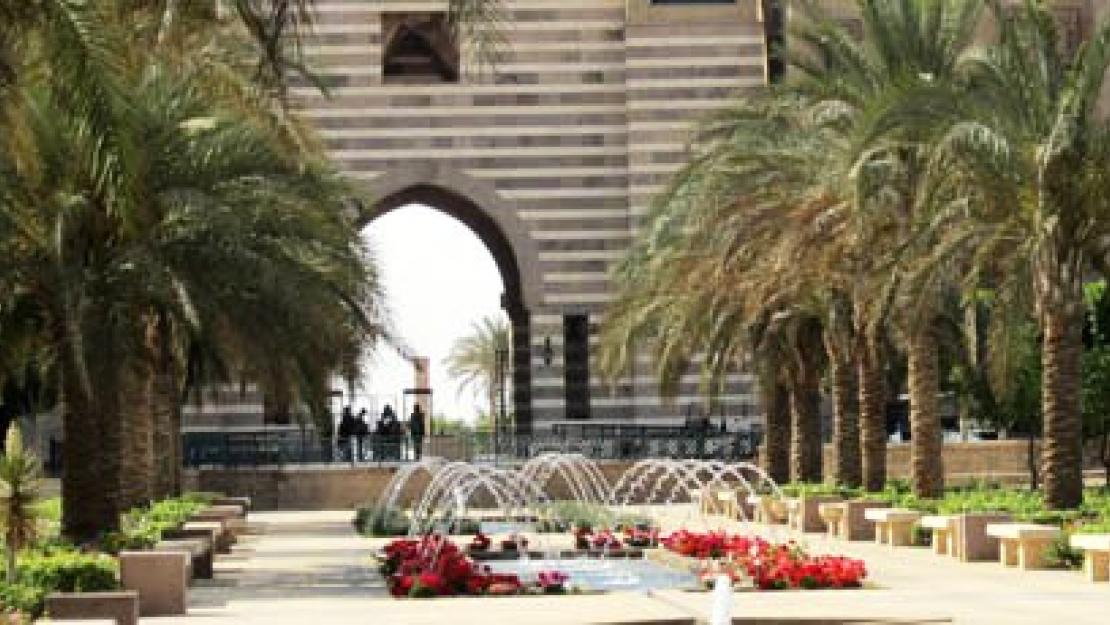By Tess Santorelli
For Farkhonda Hassan (MSc '67), the phrase "mother knows best" takes on an entirely new meaning.
Hassan, professor emerita in the School of Sciences and Engineering, has been teaching at AUC for 55 years. Her extensive list of students includes Her Majesty Queen Rania Al Abdullah of Jordan '91 and Nabil Fahmy '74, '77, Egypt's former foreign minister and founding dean of the School of Global Affairs and Public Policy. Yet, she has some particular students she especially enjoyed teaching at AUC -- her children and grandchildren.
Hassan's daughter, Wegdan Lotfi '79, '91, was previously an adjunct faculty member at AUC's Department of Chemistry and had taught her own children as well, including Omar Khalifa '08. "He got a B minus in my class," Lotfi said jokingly.
Khalifa also reflected, laughing, "Most of the people I meet say, 'Oh, your mother is Wegdan; your grandmother is Farkhonda. She taught me; she taught me!'"
As AUC's centennial approaches, Hassan, Lotfi and Khalifa sat together in the living room of Hassan's home, surrounded by photographs and family mementos, and reflected on what this centennial means to them as a multigenerational family of AUCians.
Hassan, who was present for the University's 75th anniversary in 1994, said she can't believe the centennial is this year. "I have been at AUC for more than half a century. I never imagined that I would make it to the centennial, but I really feel happy to be here," Hassan said. "I feel like I am part of AUC and AUC is part of me."
The Start of a Legacy
Hassan, who first joined AUC as a graduate student to study solid-state science in the Department of Chemistry, still finds herself happiest when she is teaching. "I'm a little bit tired of walking across the new campus between classes," she said with a smile. "But still, I find myself in the classroom."
In 1964, only a year into graduate school, Hassan was appointed assistant instructor. "Maybe I was a good teacher or something. Omar knows," she laughed, gesturing to Khalifa.
When she graduated two years later, Hassan left Egypt to earn her PhD in geology from the University of Pittsburg, after which she returned to teach geology at AUC. In addition to being a celebrated scientist and prominent professor, Hassan is also co-chair of the Gender Advisory Board of the United Nations Commission on Science and Technology for Development, as well as secretary-general and a member of Egypt's National Council for Women since 2000. Elected to the Egyptian Parliament in 1979 and serving there until 1984, Hassan is currently chair of the Commission on Human Development and Local Administration in parliament. She was also named an honorary life member of the International Parliamentary Union. In Hassan's years of teaching, she has not only taught her own children and grandchildren, but her friends' children and grandchildren as well. She recounted with amusement the number of times students in her class, who were children and grandchildren of her friends, were too shy to introduce themselves as relatives of her friends. "I feel very happy when I teach the generations of my students," said Hassan. "I'm very proud of them."
Hassan said having her grandchildren in class taught her things she didn't previously know about them. "Like Omar, for example, he's very independent. I didn't know that before," Hassan said. "I learned that when he gets an idea, he will do it no matter what. He perseveres."
Hassan recalled a time when Lotfi was in her class. She raised her hand and asked Hassan why she had received an incorrect mark on an exam when she believed she had answered every question correctly.
"She came up to the podium and asked me to show her what was wrong on her exam," said Hassan. I told her, 'You see this? I couldn't read it.' When she turned to sit down, she said something, and the entire class laughed. Mother's Day was two days away, and, apparently, she mouthed to the class, 'I'm not getting her a Mother's Day gift.'"
When she turned to sit down, she said something, and the entire class laughed. Mother's Day was two days away, and, apparently, she mouthed to the class, 'I'm not getting her a Mother's Day gift.'"



Professor Emerita Farkhonda Hassan (MSc '67) with her daughter Wegdan Lotfi '79, left; Lotfi with her father at her graduation; Omar Khalifa '09 at his graduation
Learning from the Best
After graduating from AUC's Department of Chemistry in 1979 and having her four children, Lotfi earned her master's in solid-state physics in 1991. A former member of the Suzanne Mubarak International Peace Movement and a former member of Egypt's International Economic Forum, Lotfi prides her family in their "respect for hard work."
"I love teaching because it's in my blood," said Lotfi. "My kids appreciate work -- all of them. They all took courses with me, but they knew that they had to study."
Lotfi tributes everything she learned about being a faculty member to her previous professors at AUC. "I remember any advice I was given," she reflected. "In all my life stages, I've had these beautiful professors. Everyone who taught me in the department helped me build character," said Lotfi. "I was shaped at AUC."
Unlike their mother and grandmother, neither Omar Khalifa nor his two brothers, Khaled '04 and Youssef '17 chose the science route at AUC. At first, Lotfi insisted that her eldest son, Khaled, take science courses. To convince him, she arranged for him to meet with a particularly persuasive professor.
"I left them together in her office for nearly an hour. When he came out, he told me, 'She's so kind. She convinced me to do what I want.'" Lotfi said, recalling her shock. "I asked him, 'What do you want?' and he said, 'I want to go into political science.' And that's what he did, and he started getting better grades and was happy."
From that moment on, Lotfi decided to step back from her children's studies. "When it was Omar's turn, I told him, 'You do what you want,'" Lotfi said.
As an active member of AUC's student body, Khalifa founded the Youth Alliance for Leadership and Development in Africa organization, was a member of the Student Union, served as the Master of Ceremonies for the Student Union Talk Show at Ewart Memorial Hall and was a top player for the University's water polo team.
After graduating with a bachelor's in political science, specializing in international relations, Khalifa founded his own publishing and advertising company, Omedia, in 2009. Inspired by the employment fairs at AUC, Khalifa launched Shaghalni.com in 2015. He had a five-minute meeting to pitch the idea to the person who he says inspired him the most, Naguib Sawiris. The pitch resulted in Sawiris investing in the company.
Though Khalifa describes himself as more business-oriented, he still took a class with his mother. He recalled in one of Lotfi's assignments, there was the option to either give a presentation on something small, write a paper or create a drawing.
"I draw very well, so naturally, I picked drawing," said Khalifa. "I woke up in the morning before class, and in minutes, I drew a perfect solar eclipse. When I went to class and gave it to my mother, my friend told her, 'He just made that 10 minutes ago.' She knows I'm a good artist and told me I had to do the presentation instead. He ruined the plan," Khalifa said, as his mother laughed.
Khalifa said the most important lesson learned after taking his grandmother's class was the meaning of integrity. "During lunch at her house, she wouldn't answer any of my questions regarding the course," Khalifa recalled. "Instead, she would tell me to visit her during office hours so I don't receive any extra treatment."
A member of the Alumni Council and the AUC Fund committee, Khalifa hosts yearly employment fairs on the Tahrir Square campus as his way of "giving back" to AUC for fueling his ambition. "All of my ideas and dreams were created while studying at AUC," he said.
Making it Count
"Having a family of AUCians -- my son, my daughter, my in-laws and my grandchildren -- is really great," said Hassan. "I think we belong to the AUC culture. All of us."
As a faculty member, Hassan is most proud of her students because they learn how to navigate life while studying at AUC. "It is not just a degree. It is a way of thinking and living," said Hassan.
Khalifa said AUC's impact on its students is evident throughout Egypt. "This is one of the oldest, most well-established universities in Egypt," he said. "Everywhere you go, even in the biggest companies you'll always find an AUCian on the decision-making team."
"The University gives space for students to think out of the box," Lotfi agreed. "It encourages self-development and learning to the utmost."

Omar Khalifa ('09) and daugther Carla, possibly a fourth generation AUCian?
Khalifa added that not everyone knows his family's relationship to AUC. "But when they know," chimed in Hassan, "They link everything," Khalifa finished.
"Having a family of AUCians -- my son, my daughter, my in-laws and my grandchildren -- is really great," said Hassan. "I think we belong to the AUC culture. All of us."
How would the family describe AUC? "Character-building," they agreed.
"I see students entering as freshmen, and when I see them as seniors, they've grown into completely different people," said Lotfi. "It is really quite impressive. In four years, they change. They're more confident. They are better at everything -- all because of their time at AUC."
As Lotfi spoke, Khalifa's 2-year-old daughter Carla wobbled from one chair to the next. "The fourth generation of AUCians!" Khalifa said jokingly, as everyone laughed.
"AUC is in us. I mean, we are all AUCians," said Lotfi, while Carla steadied herself against her great-grandmother.
Three Generations of AUC Families
 Lucy Amin '60 (right) with her daughter Nelly Ragai '89 at the 2016 homecoming in AUC Tahrir Square
Lucy Amin '60 (right) with her daughter Nelly Ragai '89 at the 2016 homecoming in AUC Tahrir Square Nelly Ragai '89
Nelly Ragai '89 Ragai's late husband
Ragai's late husband
Teddy Tadros '88, '97 Ragai, manager at AUC's Yousef Jameel Science and Technology Research Center, with her son and daughter -- both AUC students
Ragai, manager at AUC's Yousef Jameel Science and Technology Research Center, with her son and daughter -- both AUC students Lucy Amin '60 (third from right)
Lucy Amin '60 (third from right)
"We are a Jordanian-Saudi family that is proud of its AUCian roots, which go back to the year 1928, when our great uncle joined AUC. There are many more AUCian aunts, uncles and cousins in our family. It is the fond memories at AUC that our family takes back when we travel to our countries."
-- Rania Jabr (MA '90)
 Grandmother Najwa
Grandmother Najwa
Al Imam '58 Daughter
Daughter
Rania Jabr (MA '90),senior instructor II at
AUC Grandson
Grandson
Bassel Al-Dabbagh '18
 Grandfather Ahmed Shafic Abou Oaf (MA '77)
Grandfather Ahmed Shafic Abou Oaf (MA '77) Daughter Mervat Shafic Abou Oaf '88, '02
Daughter Mervat Shafic Abou Oaf '88, '02
(right), professor of practice in the Department of Journalism and Mass Communication;
with her son Adham Zidan '09, '14
 Grandmother Mary Dafashy '75 (right),
Grandmother Mary Dafashy '75 (right),
mother Mona Makramalla '85 (left) and
daughter Sara Meleika '11
 Mansoury and ElSoueni hope to expand Rabbit's operations outside of Egypt
Mansoury and ElSoueni hope to expand Rabbit's operations outside of Egypt





 Tarabieh is leading a team of faculty experts to create AUC's Data Hub for Climate Change Mitigation, photo by Omar Mohsen
Tarabieh is leading a team of faculty experts to create AUC's Data Hub for Climate Change Mitigation, photo by Omar Mohsen In 2016, AUC's carbon emissions in one day corresponded to 42,808 metric tons of carbon dioxide equivalent per year and 117 MTCO2e per day (pictured above), based on the 2015 published report of campus-wide emissions. In 2021, AUC's carbon emissions totaled 94 MTCO2e per day and around 2.97 MTCO2e per capita -- a considerable decrease in overall campus emissions due to implemented policies and in line with global standards.
In 2016, AUC's carbon emissions in one day corresponded to 42,808 metric tons of carbon dioxide equivalent per year and 117 MTCO2e per day (pictured above), based on the 2015 published report of campus-wide emissions. In 2021, AUC's carbon emissions totaled 94 MTCO2e per day and around 2.97 MTCO2e per capita -- a considerable decrease in overall campus emissions due to implemented policies and in line with global standards.

 Awni: "African universities and networks have a major role to play." Photo by Omar Mohsen
Awni: "African universities and networks have a major role to play." Photo by Omar Mohsen

 Laila El Baradei with Public Policy Hub members, photo by Ahmad El-Nemr
Laila El Baradei with Public Policy Hub members, photo by Ahmad El-Nemr

 Mohamed Hegazy '12
Mohamed Hegazy '12

 The student design team: Ahmad Khalil (back, center), Mariem Abutaleb (center, left), Mariam Ibrahim (center right), Lana Kurdi (bottom left) and Ingy Fawzy (bottom right)
The student design team: Ahmad Khalil (back, center), Mariem Abutaleb (center, left), Mariam Ibrahim (center right), Lana Kurdi (bottom left) and Ingy Fawzy (bottom right)



 El Farouki graduated from AUC in 1968 with a bachelor's in chemistry.
El Farouki graduated from AUC in 1968 with a bachelor's in chemistry. El Farouki and Leheta first met at AUC in 1964, and have been together ever since.
El Farouki and Leheta first met at AUC in 1964, and have been together ever since. Leheta and El Farouki at his graduation in 1968, four years after they first met.
Leheta and El Farouki at his graduation in 1968, four years after they first met. Leheta with AUC classmates at a friend's wedding.
Leheta with AUC classmates at a friend's wedding.




 Omar Khalifa ('09) and daugther Carla, possibly a fourth generation AUCian?
Omar Khalifa ('09) and daugther Carla, possibly a fourth generation AUCian? Lucy Amin '60 (right) with her daughter Nelly Ragai '89 at the 2016 homecoming in AUC Tahrir Square
Lucy Amin '60 (right) with her daughter Nelly Ragai '89 at the 2016 homecoming in AUC Tahrir Square Nelly Ragai '89
Nelly Ragai '89 Ragai's late husband
Ragai's late husband Ragai, manager at AUC's Yousef Jameel Science and Technology Research Center, with her son and daughter -- both AUC students
Ragai, manager at AUC's Yousef Jameel Science and Technology Research Center, with her son and daughter -- both AUC students Lucy Amin '60 (third from right)
Lucy Amin '60 (third from right)
 Grandmother Najwa
Grandmother Najwa Daughter
Daughter Grandson
Grandson Grandfather Ahmed Shafic Abou Oaf (MA '77)
Grandfather Ahmed Shafic Abou Oaf (MA '77) Daughter Mervat Shafic Abou Oaf '88, '02
Daughter Mervat Shafic Abou Oaf '88, '02 Grandmother Mary Dafashy '75 (right),
Grandmother Mary Dafashy '75 (right),

 AUC Portal
AUC Portal AUC Portal
AUC Portal AUC Library
AUC Library AUC Library
AUC Library